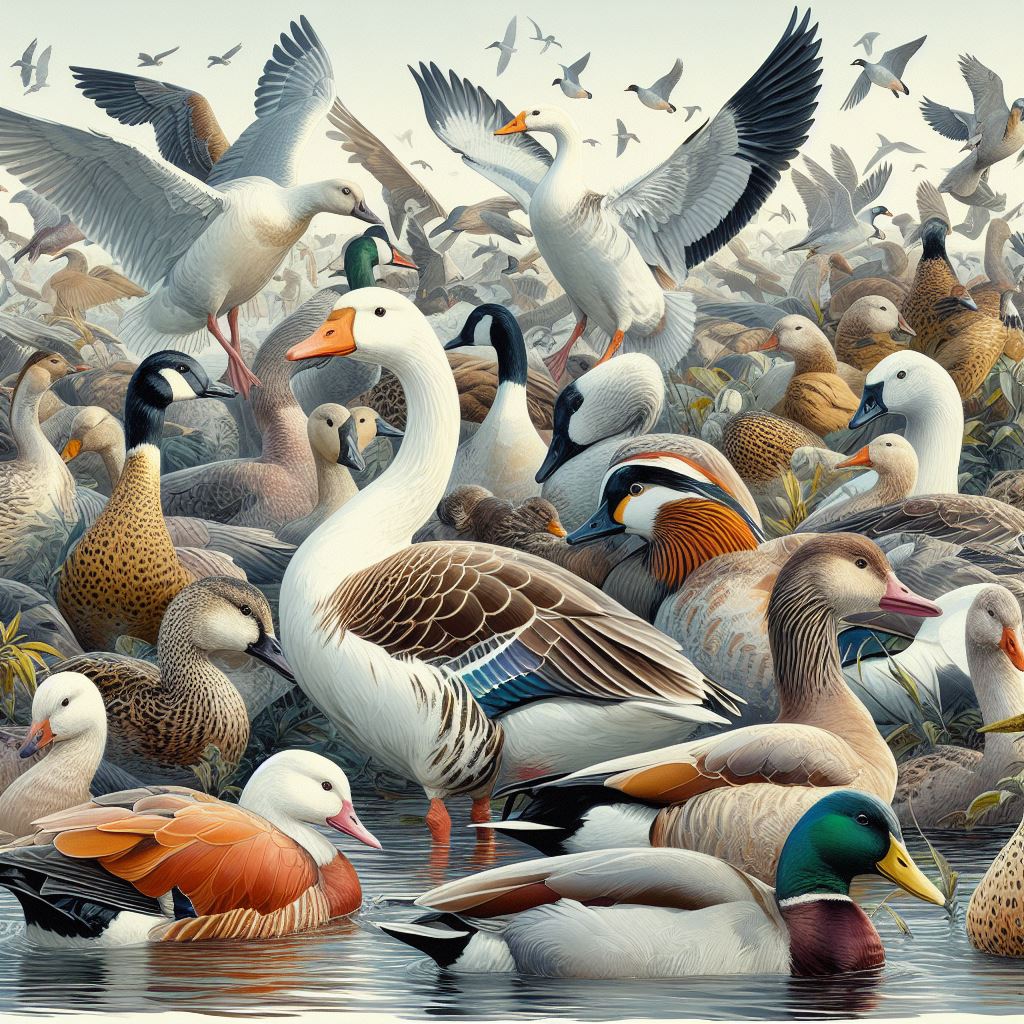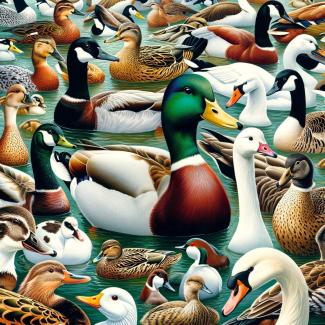
Encompassing ducks, geese, and swans, Anseriformes is a distinct order of waterfowl distinguished by their webbed feet, bills adapted for filtering food, and tendency towards aquatic living. With over 150 species dispersed across every continent except Antarctica, Anseriformes display remarkable diversity in size, habitat preferences, migration patterns, and dietary tendencies.
Anseriformes have an extensive fossil history tracing back to the Late Cretaceous period over 60 million years ago. Primitive ancestors like Vegavis iaai already displayed adaptations suited to aquatic environments.
Over epochs, Anseriformes continued honing their waterproof plumage, sensitive bill structures for locating food, and migratory instincts allowing exploitation of diverse wetland habitats seasonally.
Today's species demonstrate just how extensively waterfowl have specialized in aquatic realms. Torrent ducks nimbly swim raging Andean streams while diminutive ruddy ducks flourish on isolated prairie ponds.
Muscular mute swans establish year-round dominance over village lakes, and vast flocks of snow geese stage epic migrations between Arctic nesting grounds and southern pastures. Regardless of whether they breed across isolated subarctic tundra or ubiquitous local parks, extant Anseriformes retain key commonalities in anatomy, behavior, reproduction, and ecology testifying to tens of millions of years perfecting their water-based lifestyles.
Characteristics of Anseriformes
Physical Features
Anseriformes display a broad size range - from the diminutive 20-centimeter, 120-gram green pygmy goose to the 1-meter tall, 10-kilogram trumpeter swan. What unites them are common exterior adaptions facilitating their aquatic existence.
Flattened bills equipped with fine lamellae allow the filtering of small plants, aquatic invertebrates, and fish from water sources. Dense plumage with a downy undercoat helps repel and retain heat when swimming and diving. Webbed feet provide propulsion and agile maneuvering in water and soft substrates where webbed toes spread widely to prevent sinking.
Their positioning of feet far back on the body also generates efficient paddling power. Many species undergo a simultaneous molt rendering them flightless for weeks as they regrow high-performance wing feathers essential for aerial migration.
Behavioral Traits
Feeding almost exclusively on vegetation and small aquatic creatures, most Anseriformes must ingest substantial calories to fuel near-constant fat reserves for warmth and long migrations. Accordingly, they dedicate extensive daily time budget to foraging, whether grazing on land or diving below the surface.
Some sea ducks even demonstrate benthic feeding behaviors - descending up to 60 meters to probe muddy, seafloor sediments for mollusks and crustaceans. Clumsy walking, compressed bones, and a rigid-keeled chest provide the power needed for their aerial travels that can exceed 2500 kilometers one way.
Reproduction and Lifespan
Returning to ancestral northern breeding grounds takes advantage of short productive polar summers to raise young. There females construct Surprisingly well-insulated ground nests out of vegetation to shelter eggs. After a 21 to 32-day incubation period depending on species, highly precocial down-covered hatchlings swiftly walk to nearby water accompanied by watchful parents.
Fledged at 6 to 10 weeks, juveniles reach sexual maturity within 1-3 years. Lifespans average 10-20 years, with the oldest recorded just over 30.
Extant families
Anatidae (ducks, geese, swans)
With over 150 living species, Anatidae represents the only family within Anseriformes with surviving members. They occur naturally on every continent except Antarctica. With members displaying varied sizes, colors, and preferred habitats, defining features of Anatidae include webbed feet, dense waterproof plumage, and thin bills edged with fine tooth-like lamellae to filter small food items from mud or water. Anatidae also undergo a simultaneous wing molt which briefly renders them unable to fly during regrowth of functional flight feathers.
Anhimidae (screamers)
The sole species of surviving screamer is the horned screamer from South America. With apparent origins in the Late Cretaceous alongside early ancestral ducks, screamers represent an early branch distinct from all other Anseriformes.
While preferring wetland margins, they demonstrate key differences in diet, voice, feet, plumage, molt habits, and nesting behaviors compared to ducks, geese, and swans. Screamers' feet bear much longer individual toes suited to clambering over muddy banks and hunting terrestrial prey.
Anseranatidae (magpie goose)
Another monotypic family, the striking magpie goose is confined naturally to Australia and Wallacea. While the magpie goose bears some webbing between its toes, other features like un-lamellated bill edges tuned for grazing vegetation demonstrate its longer independent evolution in isolation from the well-established Northern Hemisphere ducks, geese, and swans. Genetic evidence suggests it diverged from these around the K-T boundary.
Global Distribution and Habitat
With members from 3 families across some 153 extant species, Anseriformes boast an impressive global distribution covering every continent except Antarctica at some point in the annual cycle. The Holarctic regions including North America, Europe, and Asia boast the highest Anseriformes species diversity and immense populations. Certain species like the mallard have achieved a nearly worldwide distribution.
Unsurprisingly given their common name of “waterfowl”, wetlands of all types including lakes, rivers, streams, ponds, marshes, estuaries, and flooded fields host Anseriformes. Coastal regions also support specialized groups of seaducks perfectly adapted to frigid and salty marine environments. Only screamers and magpie geese frequent more terrestrial settings like wet meadows and grasslands.
Myriad adaptations facilitate the Anseriformes’ intimate aquatic existence. Dense plumage granting insulation and water resistance allows swimming and diving for extended periods even amidst ice flows or frigid high altitudes. Heat exchange adaptations in their legs assist thermoregulation, while supraorbital salt glands filter excess salts from marine food sources.
Benefitting from efficient metabolic rates, Anseriformes channel precious energy reserves towards fueling migratory journeys covering thousands of kilometers between favored breeding regions and wintering locales.
By linking diverse high-productivity habitats across vast ranges annually, Anseriformes demonstrate how mastery of both aquatic and aerial realms provides extensive colonization opportunities.
Ecological Importance of Anseriformes
Anseriformes provide multifaceted ecological services within the wetland realms they influence and inhabit. As sizable migratory grazers, many waterfowl help disperse seeds and aquatic plant fragments across extensive ranges. Grazing pressures also help avoid overdominance by invasive weeds. The birds also represent mobile links transporting nutrients between marine and inland ecosystems.
Waste products of the abundant birds also enter aquatic food chains to nourish phytoplankton and zooplankton. Anseriformes directly impact ecosystems' engineering capacities as well. For example, muskrat mounds rely on persistent openings in ice cover created by foraging ducks and geese which allow oxygen circulation to submerged homes.
Diving ducks like pochards that feed heavily on mollusks also help cycle bottom sediments and reduce turbidity which improves water quality for fish communities. Anseriformes in turn fall frequent prey to myriad predators from foxes and eagles to snapping turtles and pike which help regulate waterfowl populations.
By migrating vast distances along ancient routes, Anseriformes also connect distant ecoregions that may feel limited immediate impacts from isolated habitat degradation or climate shifts. Maintaining resilient waterfowl populations ensures ecosystem balance across expansive wetland networks through seasonal movements of nutrients, sediments, energy, and reproductive potential.
Anseriformes in Nepal
Although lacking the expansive wetlands of more temperate regions, Nepal still hosts an impressive diversity of resident and migratory Anseriformes adapted to subtropical environments. Over 30 species reside or travel through Nepal annually.
Foothill lakes and rivers provide important habitats for endemic species like the threatened white-winged duck. Lowland floodplain wetlands and swamps in the Terai sustain greylag geese and spot-billed ducks. High-altitude lakes and streams host migratory birds like the bar-headed goose perfectly adapted to traversing Himalayan passes exceeding 5 kilometers in height.
Other visitors like the northern pintail and common teal descend from Siberian breeding grounds to overwinter in Nepal's relatively balmy wetlands. While Nepalese populations of many duck species remain abundant, habitat loss and agricultural runoff pose threats for the future. Groups like the National Trust for Nature Conservation promote wetland conservation awareness.
Waterfowl have long provided subsistence hunting opportunities in rural regions and feather/down collection for insulation. Images of ducks feature prominently in Nepalese art, textiles, and literature. Resident species like the spot-billed duck even receive divine reverence at certain temples in Kathmandu.
Ensuring the persistence of essential wetland ecosystems promises to maintain healthy Anseriformes populations and retain their cultural significance for generations to come.
Conservation Challenges and Efforts
While most Anseriformes species remain abundantly dispersed worldwide, habitat pressures have pushed several towards endangered status. As of 2022, the IUCN Red List classifies over 20 species as vulnerable, endangered, or critically endangered - including Madagascar pochard, Campbell teal, white-winged duck, and Hawaiian duck.
Wetland drainage for agriculture and development represents the primary threat facing Anseriforme's long-term viability. Over 50% of wetlands have disappeared in North America, Europe, and Asia since 1900 - destroying essential breeding, migratory and wintering habitats. Hunting also pressures certain duck and goose populations.
Climate shifts create a mismatch between arrivals and essential food availability. Coastal birds face challenges from oil spills, bycatch fishing, and lead poisoning. However, coordinated conservation efforts involving monitoring, habitat protection, hunting regulation, and campaigns to increase awareness have achieved success.
For example, the multinational North American Waterfowl Management Plan bringing together Canada, the USA, and Mexico promotes coordinated wetland conservation. Reintroduction programs have saved Hawaiian ducks and Laysan ducks from the brink of extinction. Groups like Ducks Unlimited and the Wildfowl and Wetlands Trust maintain, restore, and create millions of acres of habitat annually across duck breeding ranges.
Targeted research continuously enhances understanding of migration patterns, diet, nesting needs and connectivity issues to refine conservation actions through adaptive processes. Maintaining healthy wetland networks through stewardship promises continued resilience for waterfowl populations.
Conclusion
Anseriformes’ impressive resilience over 60 million years of shifting eras and continents testifies to the adaptive capacities honed amongst the order’s diverse members. By pooling collective strengths as a taxonomically cohesive guild, Anseriformes refined the essential tools needed to prosper in myriad aquatic habitats. Mastering seasonal migrations fueled access to immense resources manifest in distant locales.
Today ducks, geese, and swans deliver valuable ecosystem services facilitating nutrient transport, sediment shifting, and food web dynamics across vast areas linked through seasonal movement. Preserving intact wetland networks maintains balance not just for Anseriformes but entire watershed assemblages dependent on their waste production, vegetation clearing, and cycling inputs.
While populations overall remain robust for most species, escalating wetland loss and mounting anthropogenic pressures give reasons for concern moving forward. However, heartening success stories confirm that coordinated interventions through habitat conservation, hunting limits and community engagement provide means to safeguard Anseriforme's resilience.
Nepal’s web of foothill streams, Terai swamplands, and high-altitude lakes have long sustained vibrant waterfowl richness. Ensuring the continuity of traditional stopovers and overwintering grounds represents a shared priority across South and East Asia to uphold essential migratory flyways.
Maintaining these international resources secures the future for both far-ranging visitors and Nepal’s distinctive endemic species - thereby preserving balanced wetland ecologies and retaining important cultural heritage.

